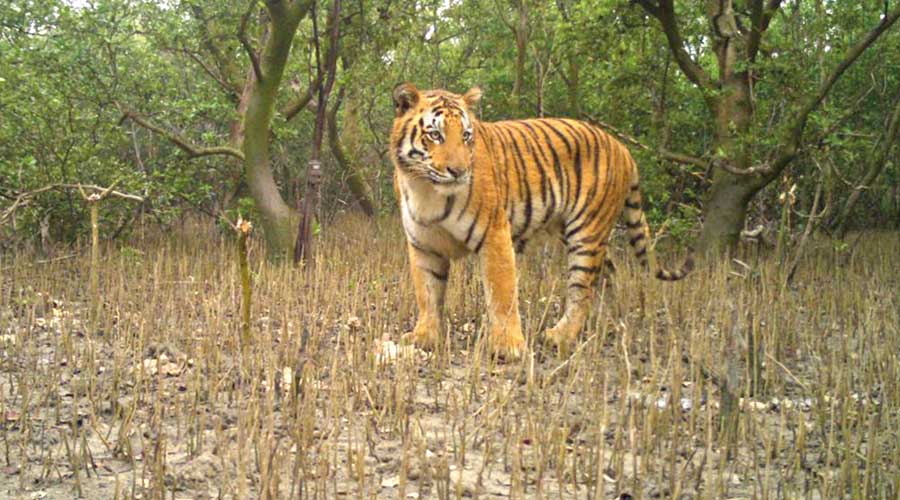Sunderbans has scored a ton in tiger count, according to the latest National Tiger Census; but it is ranked 31 out of 51 tiger reserves in the country, according to a recently published report.
The summary version of the report titled Management Effectiveness Evaluation (MEE) of Tiger Reserves, 2022, was prepared by the Wildlife Institute of India, Dehradun, and National Tiger Conservation Authority and released by Prime Minister, Narendra Modi, in Mysuru along with the Status of Tigers 2022 report. He also released the government's vision for tiger conservation during Amrit Kaal and launched the International Big Cats Alliance (IBCA).
The decline
A comparative analysis of the MEE report shows that though Sunderbans has been rated “very good” in all five cycles of assessment; its overall ranking has been consistently declining since the last two decades. According to data, the Sunderbans was ranked second among 28 tiger reserves assessed in 2006, eighth among 39 tiger reserves in 2010, fifth among 42 tiger reserves in 2014, 22nd among 50 tiger reserves in 2018 and 31st among 51 tiger reserves assessed during 2022.
The tiger census report shows that the Sundarbans tiger number has increased from 88 to 100 between 2018 and 2022.
Staff crunch a concern
A member of the evaluation team said the lack of adequate manpower is Sunderbans’ main challenge. The most important thing is to increase staff strength which was about 50 per cent when it was evaluated, as lack of enough staff is affecting several areas. For example, the performance of eco-development committees can be improved with micro-planning to better livelihood opportunities for people, which in turn would discourage them from entering the forest area,” V.K. Verma, chairperson of the team that evaluated Sunderbans in 2022, told The Plurals.
Verma further pointed out that the area development committees need to be functional under divisional commissioners to monitor illegal tourism; and more management coordination is required between India and Bangladesh Sundarbans’ forest areas.
”The tiger census report also highlights that “The unique geographic location of Sunderbans makes it vulnerable to climate change and submergence from sea level rise” and “The deltaic region faces a substantial amount of accretion and erosion every year … the north-west side of the tiger reserve is bordered by numerous villages who and largely belong to the agrarian community. These villagers are highly dependent on natural resources for their livelihood.”
Senior forest officials of the state argued that Sunderbans has been doing well in major issues like poaching and tiger-human conflict.“We do not agree with the ranking. Also staff shortage haunts most tiger reserves and Sunderbans is no exception. But on the other hand, poaching and tiger-human conflict have been largely controlled here,” said Soumitra Dasgupta, head of forest forces in West Bengal.

“To improve overall management, we have decided to include three ranges from South 24-Parganas forest division, namely Matla, Raidighi and Ramganga with the Sunderbans tiger reserve; and expect the National Tiger Conservation Authority to give clearance. Once approved, Sunderbans tiger reserve will be the biggest in the country,” added Dasgupta.
The Sundarbans tiger reserve at present has an area of around 2585 sq km, which may become about 3,600 sq km once the tiger reserve gets expanded and this will push Nagarjunasagar Tiger Reserve of Andhra Pradesh to the second berth which is currently the biggest tiger reserve in the country with around 3296 sq km area.
Dasgupta said that such integration will help tiger management in Sunderbans. “Firstly, the staff strength will be enhanced as they will have to go through stronger training and monitoring protocol; and secondly, much intense management can be provided and less straying will occur apart from staff gaining financially”.
“These ranges are tiger habitats and hence can be better managed once these are added to the tiger reserve area,” opined Biswajit Roychoudhury, a wildlife expert and member of state wildlife advisory board. “Sundarbans, including the forest covering both present tiger reserve and South 24 parganas district, has been under increasing climate change impacts; and it is important to carry out the related assessment. Once integrated, it will be possible to have a holistic understanding of climatic impact on the Sundarbans forest,” added the expert.
“Sunderbans was ranked second in 2006; but has slipped since then. We need to know why this is happening even as it has done well in key issues like poaching and tiger-human conflicts,” pointed out Pradeep Vyas, a senior forester.
Joydeep Kundu, a tiger expert and member of the state wildlife board, also countered the ranking arguing that the Joint Forest Management Committees are doing well and steps like installing nylon nets around the forest areas of Sundarbans to stop straying of big cats into human habitats, has paid rich dividends to the pristine forest area.
